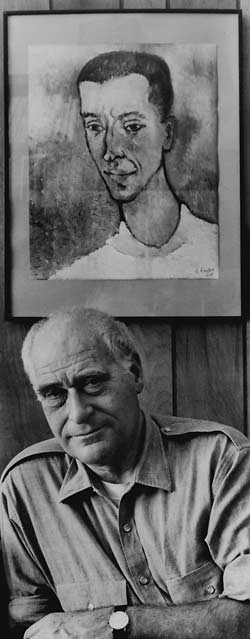UC Berkeley Press Release
Science luminaries gather for symposium
BERKELEY – Noted neurologist Oliver Sacks, three Nobel Prize winners, and a cadre of other brilliant scientific minds are gathering on Saturday, April 9, at the University of California, Berkeley, for a symposium in honor of Emeritus Professor of Neurobiology Gunther Stent.
 Gunther Stent |
The rare and delightful gathering will feature a wide-ranging discussion of science, art and philosophy - and a chance to celebrate Stent's 80th birthday. Stent, the first chairman of UC Berkeley's Department of Molecular and Cell Biology, was a member of the original group of scientists called the "phage group" that included James D. Watson and Francis Crick. These scientists from around the world solved the basic mysteries of the gene and how DNA functions, and developed the central dogma of modern genetics.
"Hopefully, we'll hear about new issues and thoughts," said Michael Botchan, UC Berkeley professor of biochemistry and molecular biology. "It's a celebration of Gunther - he's such a polymath."
Stent said he was "overwhelmed" at the idea of the symposium in his honor, adding that he planned to talk about the people who helped him in his career, starting with his elementary school teacher.
Stent, who fled Nazi Germany as a teenager, is credited with fundamental contributions in three distinct fields: molecular biology, neurobiology, and the history and philosophy of science. Today, Stent said, he is most interested in moral philosophy and the paradoxes of the human mind.
"Gunther is one of the leading intellectuals of the era - one of the last generalists," said John Searle, a speaker at the symposium and Mills Professor of the Philosophy of Mind and Language at UC Berkeley. "He is a Renaissance man."
Stent volunteered the secret to his success: "I have a very short attention span," he said, laughing. "I get bored very quickly."
In keeping with Stent's varied interests, symposium speakers will represent a number of scientific fields:
- Sydney Brenner, of the Salk Institute for Biological Studies, won the 2002 Nobel Prize in Physiology or Medicine. A pioneer in genetics and molecular biology, his recent work involves studying vertebrate gene and genome evolution.
- Eric Wieschaus, of Princeton University, won the 1995 Nobel Prize in Physiology or Medicine for discoveries in the genetic makeup of fruit flies that explain embryonic development in humans.
- Searle, of UC Berkeley, is best known for his critique of computationalism and artificial intelligence, his work on consciousness and his theory of intentionality.
- Oliver Sacks, of the Albert Einstein College of Medicine, is a noted author and neurologist focused on how individuals survive and adapt to different neurological diseases and conditions, and what that reveals about the mind.
- Dale Purves is the George B. Geller Professor in the Center for Cognitive Neuroscience at Duke University Medical Center. He researches visual perception and its neurobiological underpinnings.
- Manfred Eigen, of the Max Planck Institute for Biophysical Chemistry, won the Nobel Prize for Chemistry in 1967 for developing a method to keep track of extremely fast chemical and biochemical processes.
- George Klein, former head of the Department of Tumor Biology at the Karolinska Institute in Stockholm, is involved in projects about the Epstein Barr virus, oncogenes and tumor suppressor genes.
The symposium will be held in the Genetics & Plant Biology Building's E. Morris Cox Auditorium from 9 a.m. to 5:30 p.m.. There will be sessions on "Semantic Relation of Genome to Phenome," by Brenner and Wieschaus; "Consciousness," by Searle, Sacks and Purves; and "Meaning in Art and in Science, by Eigen and Klein. Stent will close the symposium with remarks at 4 p.m.
"Gunther has been interested in all these things," Botchan said. "He's been in many of these fields."
Stent came to UC Berkeley in 1952 as an assistant research biochemist. Over the years, he helped shape and develop new departments and programs, including the Department of Virology in 1957 and the Department of Molecular Biology in 1964. He was director of the virus laboratory and chairman of the Department of Molecular Biology from 1980 to 1986, and was the founding chairman of the much expanded Department of Molecular and Cell Biology from 1987 to 1992. He specialized in the mechanisms underlying embryonic development of the nervous system.
Upon studying neurobiology while on a sabbatical in 1972, Stent began working with the leech, ultimately publishing over 100 articles on his work with them. From 1974 to 1981, he developed and maintained a leech colony that supported the Stent group's research in neuroembryology and neurophysiology. This work led to a patent on a new anti-coagulant, hementin, and a major exporting business until the spraying of an herbicide in 1982 nearby wiped out most of the delicate colony at the Gill Tract in Albany.
His textbook "Molecular Genetics" (1970, 1978) is regarded as a classic, and he authored "Phage and the Origins of Molecular Biology" with James D. Watson and John Cairns (1966, 1992) and edited "Function and Formation of Neural Systems" (1977) and "The Double Helix: a personal account of the discovery of the structure of DNA" with Watson (1980).
His autobiography, "Nazis, Women and Molecular Biology," was published in 1998.

